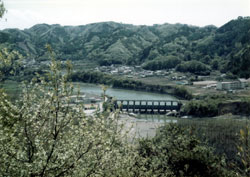MONTHLY NEWS Describing Your Hometown in a Nutshell |
How would you respond if you were asked to describe your hometown in just one word? Between late June and mid-July, Sumitomo Life Insurance Co. conducted a survey of 6,000 people across Japan in which they asked respondents to give a single kanji (Sino-Japanese character) that best describes their image of their native region. The Japanese writing system consists of two kinds of characters: kana and kanji. Kana letters, like the English alphabet, represent specific sounds. There are two sets of kana, hiragana and the katakana, each consisting of 48 letters. Kanji characters, meanwhile, have specific meanings. Using kanji, the Japanese can describe images not in one word but in just one character. Aren't they convenient? Japan looks like a small country on the world map, so you may think that there isn't much of a difference wherever you go. But in reality, Japan is a long and narrow archipelago extending a long distance from north to south, so there's a great deal of regional variation. If you compare it to the Americas, the northern tip is roughly the same latitude as Prince Edward Island in Canada, and the southernmost island is around the same latitude as Cuba. People from the northern regions of Hokkaido and Tohoku, where winters are cold and long, most frequently chose the kanji for "snow" as the character that best represents their hometown. Those from the southern regions of Shikoku and Kyushu chose the kanji for "sea" or "ocean," while the people of Honshu, located around the middle of the archipelago, gave the kanji for "mountain." (Grammatically, the Japanese language makes no distinction between singular and plural.)
Regional characteristics become more obvious when the top survey results are seen by prefecture. The most popular kanji for Kyoto, which has many historic buildings and gardens that were added to the World Heritage List in 1994, was the character for "temple." The character best describing Shiga Prefecture, the home of Lake Biwa, Japan's largest lake, was "lake." "Rice" was chosen for Niigata Prefecture, which grows Koshihikari - said to be the best rice in Japan - and "tea" for Shizuoka Prefecture, where excellent green tea is grown. Some of the more remarkable results include "festival" for Fukuoka Prefecture, which is known for lively festivals - the Dontaku in the spring and the Gion Yamagasa in the summer - and "city" for the Tokyo metropolis. (In addition, the second most popular choice for Tokyo was "capital.") Many locally popular choices can be seen in the second and third places. "Strawberry" came in second place for Tochigi Prefecture, Japan's biggest producer of strawberries, while "noodle" was the third most popular character for Kagawa Prefecture (in Shikoku), which is famous for noodles called Sanuki udon. The character that came in second place for Kyushu's Kagoshima Prefecture, the home of the active volcano Sakurajima, was "ash." The third most frequently cited kanji for Nara Prefecture, whose Nara Park is inhabited by free-roaming deer, was "deer." In one prefecture, the top choice was "mother," followed by "food" and then "laughter." You may wonder what region in Japan produces so many eccentric and openhearted people. It's Osaka Prefecture, the capital of which is the third most populated city in Japan. Now let's take a look at the national results. The most popular kanji nationwide was "mountain," chosen by 12.9% of respondents. The character for "sea" or "ocean" came in second, with 10.7%. Together, these two characters collected over 20% of the votes. "Paddy field" was fourth, "greenery" fifth, "snow" sixth, and "river" seventh. It seems that an overwhelming number of the people of Japan, a country surrounded by water and having many mountains and hills, associate their native regions with some form of nature. The third most popular choice, by the way, was "mother," selected by 5.5% of respondents. Other family-related kanji included "house" or "home" in ninth place and "parent" in thirty-second place. In Japan, people have a custom of going back to their native regions in the New Year and during the Bon season in the summer. Judging from the survey results, it appears that many Japanese look forward to going back to their hometowns twice a year to regain touch with the good old mountains, rivers, and sea and spend time relaxing with their families. Photos: (Top) The kanji for "sea" was the second most popular choice nationwide; (bottom) The character for "river" was another popular choice. (Nobusato Matsuzaki) |

|

